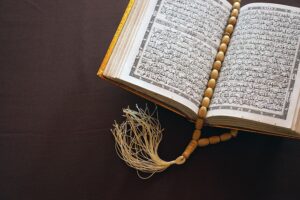Makharijul Al-Huruf, the articulation points of Arabic letters, is essential for accurate pronunciation in Arabic and Quranic recitation. Each letter has a specific Makhraj, or articulation point, located in the mouth, throat, or nasal passage.
Mastering these points ensures clear communication and preserves the meanings of words, which is especially important in Quranic recitation. The Quran, revealed in classical Arabic, requires precise pronunciation to maintain its linguistic and spiritual integrity.
Proper articulation, a key aspect of Tajweed, safeguards against altering meanings and upholds the sanctity of the Quran. Therefore, understanding Makharej Al-Huruf is crucial for anyone learning Arabic or reciting the Quran.
In this article, we will discuss together what Makharej Al-Huruf are, its immense importance, and how to practice it properly.
Table of Contents
What Are Makharij Al-Huruf?
To be able to decipher this term, we need to have a clear definition of Makharij Al-Huruf. In Arabic, ‘Makharij Al-Huruf’ simply refers to those accurate points of articulating the Arabic letters, when pronouncing them. It is more like the phonetics in English; both are about how the letter makes its own sound, throughout the interaction of the vocal organs, such as throat, tongue, lips, and so on.
Each letter has a specific point in the mouth, throat, or nasal passage where it is pronounced. Mastery of these points ensures clarity in communication and preserves the meanings of words, which is particularly crucial for accurately reciting the Quran.
Makharij Al-Huruf can be studied and applied, as a part of the Arabic language and Tajweed, to be able to recognize how to pronounce the letters precisely, and in turn, to recite the Qur’an duly, as it was descended.
Understanding Makharij al-Huruf involves recognizing how letters are produced through interaction between vocal organs. This knowledge aids in avoiding mispronunciations that could alter meanings. Proper articulation is a key component of Tajweed, which is vital for maintaining the Quran’s linguistic and spiritual integrity.
Learning these articulation points enhances overall language proficiency and provides a foundation for advanced studies in Arabic. It also fosters a deeper connection to the Quran, making recitation more meaningful and spiritually fulfilling. To learn Makharij al-Huruf effectively, one should study the Arabic alphabet, use visual aids, watch instructional videos, and practice regularly, possibly with guidance from a trusted academy.
Importance of Learning Makharij Al-Huruf:
Learning Makharej Al-Huruf, the articulation points of Arabic letters, is crucial for anyone seeking proficiency in the Arabic language and accurate Quranic recitation.
1- It Ensures Accurate Pronunciation:
Mastering Makharej Al-Huruf ensures precise pronunciation of Arabic letters, which is crucial for clear communication. Accurate articulation helps avoid misunderstandings and conveys the intended meaning correctly, as Arabic words can change meanings with slight variations in pronunciation.
2- Enhanced Language Proficiency:
Understanding and practicing the correct articulation points enhances overall language proficiency. It enables learners to speak more fluently and confidently, improving their ability to engage in conversations, read texts accurately, and write correctly.
3- Foundation for Advanced Studies:
Learning Makharej Al-Huruf provides a solid foundation for more advanced studies in Arabic linguistics and literature. It is essential for those pursuing fields such as Arabic poetry, rhetoric, and classical texts, where precise pronunciation and deep understanding of the language’s phonetic structure are critical.
4- Precise, and Proper Recitation of Qur’an:
As Muslims, we are commanded to recite Allah’s Holy Book properly, flawlessly as it was descended:
“ فَإِذَا قَرَأْنَاهُ فَاتَّبِعْ قُرْآنَهُ“
“So when We have recited it [through Gabriel], then follow its recitation.” [Al-Qiyamah: 18]
5- Preserved, Clear Meanings of Qur’an:
In the Arabic Language, even the slightest mispronunciation of any letter can change the whole letter to another, and consequently the entire word, and meaning! So, articulating the words right, for sure, preserves their intended meanings.
6- Deep, Heartfelt Connection:
When you pronounce each Qur’anic letter correctly and harmoniously, your recitation will sound whole, and just right, and in turn, it will melt your heart, purify your soul, and increase your faith, feeling connected to the Creator, through His Word- the Qur’an:
إِنَّمَا ٱلْمُؤْمِنُونَ ٱلَّذِينَ إِذَا ذُكِرَ ٱللَّهُ وَجِلَتْ قُلُوبُهُمْ وَإِذَا تُلِيَتْ عَلَيْهِمْ ءَايَٰتُهُۥ زَادَتْهُمْ إِيمَٰنًا وَعَلَىٰ رَبِّهِمْ”
“يَتَوَكَّلُونَ
“The believers are only those who, when Allah is mentioned, their hearts become fearful, and when His verses are recited to them, it increases them in faith; and upon their Lord they rely -” [Anfal: 2].
7- Blessing Rewards, During Both Cases:
There is no learning, more honorable, or more rewarding than that of the Qur’an, Allah’s Holy Book. Every step you take in this blessed journey of learning Qur’an, whether how to recite, or how to understand, to act, is abundantly rewarded by Allah, from starting, until getting skilled in the Qur’an.
The Messenger of Allah (ﷺ) said, “The one who is proficient in the recitation of the Qur’an will be with the honorable and obedient scribes (angels) and he who recites the Qur’an and finds it difficult to recite, doing his best to recite it in the best way possible, will have two rewards.” [Muslim, and Bukhari].
What Are the Makharij Types?
Points of articulation are the product of muscle interaction or airflow passing some organs. In Arabic, there are two main types of the Makharij (the exit-points of the letters):
1- The General Makhraj:
It is the ‘general Makhraj’, which encompasses the whole, main articulation-place, where the letter is produced.
2- The Particular Makhraj:
It is the ‘particular Makhraj’, which is the own, specific articulation-existence of each letter.
Example:
The Arabic letter ق /Qaf/: Its main, general Makhraj is: the tongue, whereas its specific Makhraj is the extreme back of the tongue touching the upper palate.
What Are the Letters Makhraj groups?
In Tajweed, the articulation points (Makharij) of Arabic letters are categorized into five main groups: Al-Jawf (empty space in the throat and mouth), Al-Halq (throat), Al-Lisan (tongue), Ash-Shafatan (lips), and Al-Khayshoom (nasal cavity). These groups ensure precise pronunciation essential for proper recitation of the Quran.
What Are the Makharij of the Arabic Letters?
As we said, Makharij Al-Huruf are the articulation-points of the Arabic letters, when getting pronounced. In Arabic, the letters are produced through five main, general pronouncing-positions, as well as those included, particular exist-points of the letters:
1- Al-Jawf (the Empty Space of Mouth and Throat):
It is not a literal ‘organ of speech’, yet that airflow passing through the empty space of throat and mouth can produce three, essential letters, those called ‘Huroof Al-Madd’ (the Prolonging Letters): / ا / (aaa), /و/ (ooo), /ي/ (eee).
The sound of “ا” (Alif) can be produced from this area, as in سَمَاءِ (sama’) – Surah Al-Baqarah (2:22).
2- Al-Halq (the Throat):
Al-Halq refers to the throat, that plays a distinctive role in producing some, certain letters, through releasing or constricting the airflow going in there; it is a main, general Makhraj, consisting of three, specific Makharij:
1- The Lowest Part of the Throat:
Producing the letters /أ/, (a), and /ه/ (ha), through constricting the airflow at the lowest part of the throat. The sound of “ه” (Haa) is articulated from this area, as in هَذَا (hatha) – Surah Al-Baqarah (2:2).
2- The Middle Part of the Throat:
Producing the letters /ع/ (‘a), and /ح/, through constricting the airflow at the middle part of the throat. The sound of “ع” (Ayn) originates here, as in عَلِيمٌ (aleem) – Surah Al-Baqarah (2:32).
3- The Highest Part of the Throat:
Producing the letters /غ/ (gha), and /خ/ (kha), through constricting the airflow at the highest Part of the throat. The sound of “خ” (Khaa) is articulated here, as in خَالِدِينَ (khalidina) – Surah Al-Baqarah (2:25).
3- Al Lissan (the Tongue):
Al-Lissan refers to the tongue, which is one of the main, general Makharij Al-Huruf; it consists of three specific Makharij:
1- The Back-Part of the Tongue:
Producing the letters /ق/ (Qa), and /ك/ (ka), as the back of the tongue touches the upper palate, creating a thick sound in /ق/, whereas the back of the tongue nearly touches the upper palate, creating a thin sound in /ك/.
The sound of “ق” (Qaf) is produced from this area, as in قَوْمٌ (qawm) – Surah Al-Baqarah (2:54).
2- The Middle Part of the Tongue:
Producing the letters /ش/ (sha), /ج/ (ja), /ن/ (noon), and /ي/ (ya), through the middle part of the tongue connecting to the upper palate opposite to it. The sound of “ن” (Noon) is articulated here, as in نَفْسٍ (nafs) – Surah Al-Baqarah (2:286).
3- The Side of the Tongue:
Producing the letters /ض/ (Ddha), and /ل/ (la); in /ض/, one side of the tongue, or both, its rear touches the upper back teeth, the right, or the left, or both, whereas in /ل/, the side of the tongue goes the nearest point at the front of the tongue, with the tip of the tongue touching the middle of the upper gums, and teeth.
The sound of “ل” (Laam) is articulated here, as in لَكُمْ (lakum) – Surah Al-Baqarah (2:2).
4- The Tip of the Tongue:
Producing the letters: /ر/ (ra), /د/ (da), /ط/ (tta), /ت/ (ta), /ص/ (Ssa), /س/ (sa), /ز/ (z), /ظ/ (ZZa), /ذ/ (dha), and /ث/ (tha). Each letter of those has a distinct sound produced by various tongue-tip contact with the inside, opposing gums, and teeth.
The sound of “ت” (Taa) can be produced from this area, as in تَفَكَّرُونَ (tafakkaroon) – Surah Al-Baqarah (2:164).
4- Shafatain (the Lips):
The lips is the general Makhraj, which consists of two specific Makharij:
1- Using One Lip:
The letter /ف/ (fa) is pronounced by pressing the upper front teeth against the inside-part of the lower lip. The sound of “ف” (Faa) is articulated with one lip, as in فَإِنَّ (fa inna) – Surah Al-Baqarah (2:23).
2- Using the Two Lips:
The letter /ب/ (ba): It is similar to /b/ in English; it is pronounced by pressing the two lips together firmly, and releasing them quickly. The sound of “ب” (Baa) is produced with one lip, as in بِسْمِ (bismi) – Surah Al-Fatiha (1:1).
The letter /م/ (ma): it is similar to /m/ in English: it is pronounced by pressing the outer parts of lips together, while the airflow goes out through the nose. The sound of “م” (Meem) is articulated here, as in مَاءٌ (ma’) – Surah Al-Baqarah (2:22).
The letter /و/ (wa): it is similar to /w/ in English, and it is other than of /و/ /oo/, the prolonging-letter. It is pronounced by incomplete joining the two lips together, while the airflow pass through the mouth. The sound of “و” (Waw) is articulated using both lips, as in وَإِذَا (wa idha) – Surah Al-Baqarah (2:26).
5- Khayshoom (The Nasal Cavity):
Khayshoom is the bridge of the nose, its furthest part; it is a connecting-point between the mouth and the highest point of the nose.
Ghunna is that nasalized sound produced when pronouncing the Arabic letters: /م/ (m), and /ن/ (n), and specially when it is doubled by shaddah; it is like a slight tone-vibration in the nasal cavity. The nasal sound “ن” (Noon) can also be produced from this area, as in مِنْ (min) – Surah Al-Baqarah (2:2).
What are the The rules of the points of articulation (Makhraj) in Tajweed?
The rules of the points of articulation (Makhraj) in Tajweed are essential for proper pronunciation of the Arabic letters in the Quran. Here are the key rules:
1- Understanding Makhraj:
Each Arabic letter has a specific point of articulation where it is produced. Knowing these points helps in pronouncing letters correctly.
2- Distinctiveness:
Each letter should be pronounced clearly and distinctly from others. This means ensuring that the sound produced does not resemble that of another letter.
3- Lengthening (Madd):
Certain letters require elongation when followed by specific letters or conditions. For example, a Madd letter followed by a Hamzah or a Sukoon requires a longer pronunciation.
4- Ghunnah (Nasal Sound):
Some letters, particularly “ن” (Noon) and “م” (Meem), require a nasal sound (Ghunnah) when they occur in specific contexts, such as in Idgham or Ikhfaa.
5- Saktah:
A brief pause without taking a breath, often indicated by a small symbol in the Quran. It is used to enhance clarity without interrupting the flow.
6- Idgham:
This involves merging two letters, particularly when a letter with a Sukoon follows a letter with a vowel. Understanding the rules of Idgham helps in maintaining the flow of recitation.
7- Iqlab:
This rule applies when a “ن” (Noon) with a Sukoon is followed by a “ب” (Baa). The “ن” is pronounced as “م” (Meem) with a nasal sound.
8- Ikhfaa:
This rule involves hiding the sound of “ن” (Noon) when it is followed by certain letters, producing a nasal sound without fully pronouncing it.
9- Emphasis (Tafkhim and Tarqeeq):
Some letters are pronounced with emphasis (Tafkhim) while others are pronounced lightly (Tarqeeq). This affects the overall sound and clarity of recitation.
How to Identify the Makhraj of Any Arabic Letter Easily?
You can identify the Makharaj of any Arabic letter, by putting /A/ hamza /أ/ before the letter, and pronounce it in sukoon -without any vowels.
For example, try pronouncing /ق/ (Q)! Turn it to /AQ/, and pay attention to yourself pronouncing it; actually, you will find the back of the tongue touching the upper palate, making that thick sound.
How to Learn Makharij Al-Huruf?
As said, learning Makharij Al-Huruf will boost your recitation-skill of Qur’an; so, you can find your own learning way that suits you the best; here are some tips and tricks:
1- Study the Arabic Letters First, Generally:
It’s important to get to know the Arabic alphabet generally, and each letter with its shape and regular sound. That makes you feel familiar with the letters, before delving into its accurate articulation-points.
2- Have a Diagram of The Articulation-Points Illustrated:
Having an illustrating diagram of Makharij Al-Huruf will help you see clearer from where the letters are coming from, when pronouncing.
3- Watch Online Videos:
Watching online, learning videos of the articulation-points of the Arabic letters will facilitate your comprehension of each letter’s exist-point, and how to identify it easily, differentiating it from any other.
4- Listen to Proper Recitations of the Qur’an:
Listening to the great Sheikhs’ recitation of the Qur’an will help you recognize the right articulation of the letters; the more you listen attentively and the more you repeat, the more ready you get to recite the Qur’an correctly.
5- Focus When Pronouncing a Letter:
Focusing while trying to pronounce the Arabic letter will make your mind more alert to the exact Makhraj (exit-point) of the letter; that will enhance your muscle-memory of the vocal organ you use when pronouncing, and in turn, make it easier for you to automatically associate every letter with its exist-point.
6- Install an Articulation-App to Practice:
It is always a great tip to follow! As online apps encourage you to keep practicing, and enhancing your skill, wherever you are!
7- Join a Trusted Academy:
If you don’t still know from where to start, you can simply join a trusted, well-known, Islamic Academy, like Bayan Academy, where there are skilled Arab-teachers who can help you learn Makharij Al-Huruf in the simplest, and most effective way.
Learn Arabic Online With Bayan al-Quran Native Arab Tutors:
Embark on a transformative journey of Arabic learning with Bayan Al-Quran’s comprehensive online Arabic courses. Our platform offers an authentic and immersive experience tailored to learners worldwide. Whether you’re a beginner or seeking to enhance your skills, our Tajweed courses provide expert guidance and structured learning to master Arabic learning.
🎓 Expert Guidance:
Benefit from experienced instructors who specialize in Arabic, breaking down complex rules into manageable segments for learners of all levels.
✨ Key Features:
- Structured, step-by-step learning approach.
- Access to high-quality instructional materials.
- Real-time feedback from qualified tutors to enhance your practice.
- Flexible learning schedules to accommodate your pace and convenience.
- Immerse yourself in the melodious tones of Quranic recitation, enriching your spiritual experience.
🌟 Why Choose Bayan Al-Quran?
Join our vibrant community dedicated to perfecting Arabic learning. Choose Bayan Al-Quran for a transformative learning experience and embark on a path to mastering Arabic with confidence.
Learn with Bayan al-Quran with Native Arab tutors. There are also several courses that can help you in this regard.
Conclusion:
Makharij Al-Huruf refers to the precise points of articulation for Arabic letters, similar to phonetics in English. Mastering these articulation points is crucial for accurate pronunciation, enhancing language proficiency, and ensuring proper recitation of the Quran.
Learning Makharij Al-Huruf helps avoid misunderstandings in communication, preserves the intended meanings of words, and fosters a deeper connection to the Quran.
Learning Makharij Al-Huruf is also part and parcel of preserving the Qur’an words and meanings, which is every Muslim’s duty; every step you take in learning how to preserve Qur’an, in all ways, is witnessed and rewarded by Allah. May Allah accept all our efforts.
To learn effectively, one can study the Arabic alphabet, use diagrams, watch instructional videos, listen to skilled reciters, and practice regularly, potentially joining a trusted academy for guidance.


















